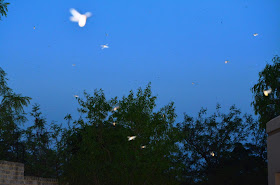 |
| Flight of the Northern Harvester Termite (Rysmier) Hodotermes mossambicus - not the best picture, but the camera doesn't see them LOL! - |
 |
| Alates (reproductives) and Soldiers [You can click on the picture to enlarge] - the one on the right took a bit of a nose dive upon lift off, they're not the best fliers :) - |
I think that we get swept up (as we do in most of our daily lives) with the time at which things 'need' to be done. With the threat of another drought looming for this year most of us are very concerned about when it will rain in order for us to get food production season going. Roodepoort had received a total of 47 mm of rain during the period of 7-23 October. On the 22nd the future kings and queens of the termites took to the sky in their masses. Their brief nuptial flight postponed (along with this year's sowing plans) by the late coming of the rain. I remember that they used to fly a lot earlier in the year with the coming of good rain, usually early September. Just short of two months past their due date, a good stretch of rain had triggered their annual cycle once again and ensured the establishment and maintenance of the next generation.
Termite swarming also means opportunity for food. All manner of predator take full advantage of the sudden oversupply and swoop, mob, peck and carry away countless prey. The swallows and bats are the most prominent predators to intercept the termites by wing. Flocks of swallows feast on the early fliers when there is still enough light in the sky, whereas bats take the night shift and any remaining fliers that emerge after dusk. Predatory insects also capture any victims who stray too close and other night time predators collect the now-wingless reproductives from the ground. Some stragglers are still left the next morning when early birds peck them up from the paving and roads.
Seeing the whole familiar scenario unfold once more was quite humbling. Taking some cues from nature in the sense that our vegetables will be planted and crop harvested. The produce may not be as bountiful or timely as we would like, but everything happens in its own time and life carries on.
oOo
Some scientific details to supplement my somewhat philosophical piece 
Termites make up their own order, Isoptera. They are not related to ants (from the order Hymenoptera), since they do not have constricted waists or elbowed antennae. The most common species in Gauteng is the Northern Harvester Termite (Afrikaans: Rysmier, translation: "rice ant"), Hodotermes mossambicus. They are not dry-wood termite and, as such they feed on grasses and twigs. They are ubiquitous and form large underground colonies even in very urbanised areas. Parent colonies release eyed, flying reproductives (alates) at dusk after a period of heavy rain. They fly a short distance, fall to the ground and detach their wings. Females produce pheromones to attract males. The pair burrow into suitable substrate and a new colony becomes established after egg laying. New colonies will only produce reproductives in a few years, but once established colonies can last for centuries.
____________________________________________________________________________________
If you enjoy the content please share with fellow gardening enthusiasts via the various sharing buttons at the end of posts/pages! Else you can vote for posts through the Google reactions bar at the end of articles. To stay up to date I have provided several reader and social networking platforms with which to subscribe: Twitter, Pinterest, RSS Feed Reader or Email/Follow directly using the Blog Followers or Follow Your Way widget on the left hand side toolbar. Thank you for reading and please feel free to ask if questions arise - I appreciate comments and ideas too! ____________________________________________________________________________________

